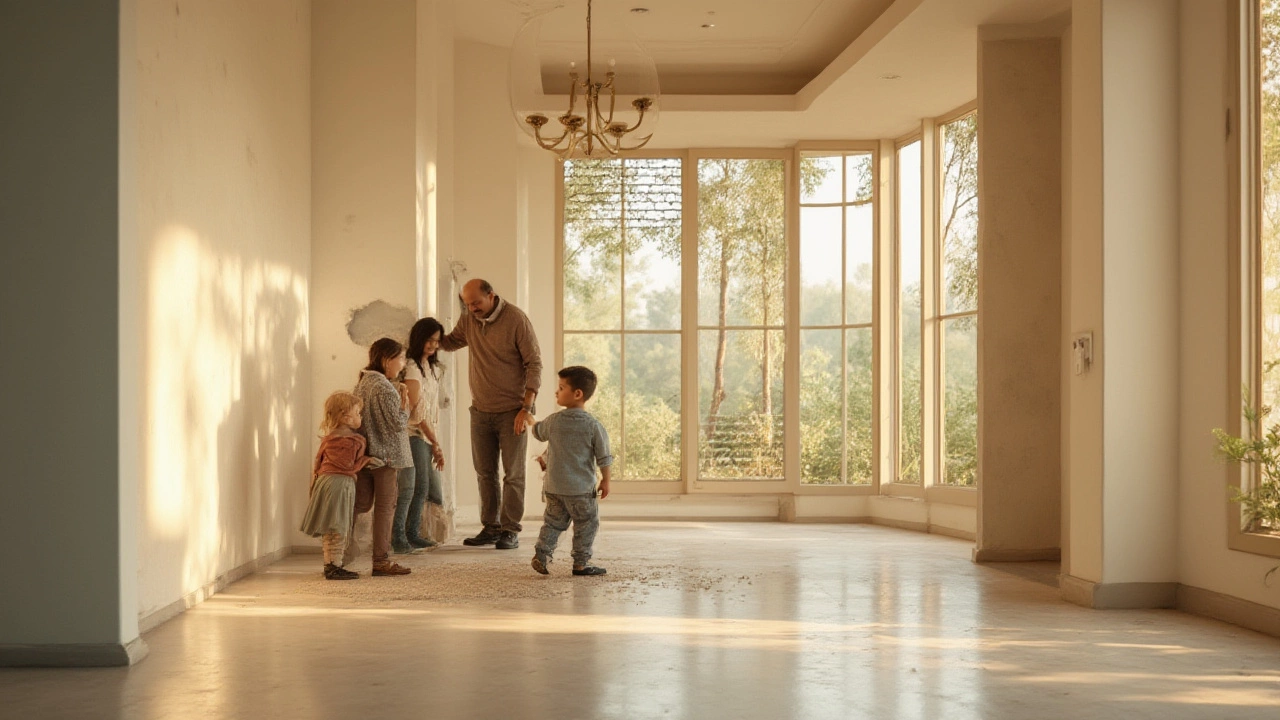What Comes With a New Build? The Complete Breakdown

You’d think buying a new build means everything’s done for you, right? Not quite. There are some big perks—brand new fittings, untouched walls, a fresh start—but it’s easy to miss a few details you’d expect to come as standard.
Want to know if the kitchen comes with all the shiny appliances you saw in the show home? Wondering if the garden is just patchy grass or actually done up? Let’s get straight to the point on what’s usually included in a new build and what might show up as an unexpected line on your invoice.
Staying sharp about the details can save your wallet and spare you last-minute headaches. If you know what to expect, you’ve got the upper hand when it comes to choosing upgrades and preparing for move-in day. Let’s lay it all out so you don’t get stung by the small print.
The Standard Inclusions
When people talk about a new build, the first question is usually: what do you actually get for your money? While the answer can vary a bit between builders and locations, most new builds in the UK and US come with some core features as part of the deal. Don’t assume it’s ‘move-in ready’ with every last detail covered—let’s break down what’s typically included.
- Central heating and double glazing: Almost every new build comes with an energy-efficient heating system and double-glazed windows as standard. This helps with warmth, safety, and cutting down bills.
- Basic flooring and wall finish: You’ll usually get finished walls (painted or magnolia/tinted), plus flooring in kitchens and bathrooms. Carpets in bedrooms or living rooms might only be included in pricier packages or special promotions.
- Basic kitchen units and worktops: Expect fully-fitted kitchen cabinets, worktops, and a sink. An oven and hob (sometimes both electric) are usually included, but other white goods—like dishwashers or fridges—are sometimes only available as upgrades.
- Main bathroom suite: The bathroom will have a toilet, basin, shower (sometimes a separate bath), and basic tiling around wet areas. En suites generally mirror this but with fewer tiles and basic fixtures.
- Electrical fittings: Plug sockets (usually white plastic), basic light fixtures (think plain bulbs rather than fancy fittings), and smoke alarms are standard on all new build homes due to building regulations.
- Security and insulation: Multi-point locking on external doors and decent loft insulation are now part of the minimum spec for most developers. This already puts new builds ahead of most older homes when it comes to energy and security.
Here’s a quick snapshot of what usually comes as standard versus what’s considered an upgrade. Not every builder includes everything—even at the same price point—so check for specifics:
| Feature | Usually Included? |
|---|---|
| Central Heating | Yes |
| Basic Kitchen (oven, hob) | Yes |
| Integrated Appliances (fridge, dishwasher) | Sometimes/Upgrade |
| Front & Rear Lawns | Usually front only |
| Carpets Throughout | Often upgrade |
| Fencing | Basic, not always around all sides |
The big benefit with new builds is that you’re getting fresh, unused infrastructure—wiring, plumbing, boilers, and heating are all brand new, with no nasty surprises hiding behind old walls. But if you want extra features, like fancy flooring or a fitted wardrobe, these are rarely included in the baseline and can cause the budget to creep up fast.
If in doubt, always ask the seller or builder for a full specification list in writing. You don’t want to assume and end up with a home missing fixtures you expected. The clearer you are now, the fewer headaches later on.
What Usually Costs Extra
Here’s the catch with most new build homes: what you see in the show house isn’t always what you get. Builders love to use upgrades and shiny extras to impress you, but when you read the fine print, some things you’d expect to be included are actually on the optional upgrades list.
Let’s reel off some stuff you’ll probably need to budget for, because they rarely come as part of the base price:
- Flooring Upgrades: Entry-level carpet and vinyl might be included for certain rooms, but wood floors, higher-end tiles, or even carpets with better padding usually cost more.
- Kitchen Appliances: Ovens and hobs are fairly standard, but dishwashers, fridges, and fancy extractor fans often aren’t. Builders might charge extra for an integrated fridge or an upgraded oven.
- Garden Landscaping: Think you’re getting a lush lawn and a nice patio? Not likely. Most developers just lay down turf or nothing at all. Fencing, patios, and driveways wider than the basics will usually have you reaching for your wallet.
- Lighting and Electrical: Check the small print—a basic lighting package is common in new builds, but spotlights, under-cabinet lighting, and extra plug sockets are usually upgrades.
- Wardrobes and Storage: Built-in wardrobes are a common feature in showrooms, but unless you’ve picked it as an extra, don’t count on them in your bedroom as standard.
- Decoration and Paint: Standard finish is usually white or magnolia walls throughout. Any personalized feature walls, upgraded skirting, or fancy paint will cost more.
Take a quick look at this table showing some common extras and average upgrade costs reported by UK buyers in 2024:
| Item | Typical Upgrade Cost (£) |
|---|---|
| Wood/Tile Flooring (per room) | 400 - 1,250 |
| Garden Landscaping (basic) | 1,500 - 5,000 |
| Integrated Appliances (per item) | 350 - 950 |
| Bespoke Lighting | 500 - 2,000+ |
| Fitted Wardrobes | 750 - 2,000 |
These prices might look a bit scary, but it’s better to know up front than get caught out when you see your upgrade options. Always double-check what’s included in your specific home, as some builders are a bit more generous than others. Ask your sales rep for a full list of extras at your first visit—that way you can plan your budget and avoid nasty surprises.

Warranties and Aftercare
Here’s some good news: buying a new build almost always gets you a decent warranty—usually more than you’d get with an older house. Most developers work with warranty providers like NHBC, LABC, or Premier, who hand out 10-year structural warranties as standard. But don’t get the wrong idea—these warranties aren’t like all-inclusive insurance.
In the first two years, your builder usually covers repairs for anything that doesn’t meet the developer’s standards. This is called the ‘defects’ or ‘snagging’ period. Found something odd, like a kitchen door that won’t close or a cracked tile? Report it, and they should sort it out without hassle. After the first two years, the warranty typically covers only essential structural issues—things like slipping roof tiles or major foundation problems. Cosmetic fixes or anything you’ve installed yourself? Those are down to you.
To give you a quick idea of the split, here’s how most 10-year new build warranties break down:
| Warranty Coverage | Years Covered |
|---|---|
| Developer covers minor defects (snagging) | 0 - 2 years |
| Major structural elements (warranty company covers) | 2 - 10 years |
Keep these facts in mind:
- The warranty is tied to the property, so it transfers to new owners if you sell before the 10 years is up.
- Make a ‘snagging list’ as soon as you move in. Walk room to room, note every little thing, and send it to your builder right away.
- Some things, like driveways or communal green spaces, might have different warranty setups—always check your paperwork.
Don’t just trust the developer to keep track; stay sharp on deadlines for reporting defects. Missing those windows means you’ll be footing the bill for even simple fixes. If you ever feel the builder is dragging its heels, warranty providers like NHBC have dispute resolution processes, so you’re not totally on your own.
The best bit? Buyers of new build homes report that these warranties help a ton with peace of mind, especially if you’re not handy or just don’t want the stress of repairs early on.
Tips for a Smooth Move-In
Moving into a new build sounds exciting, but let’s be real—things rarely go 100% to plan. Some buyers get handed their keys, walk inside, and find out the blinds haven’t been fitted or the wifi isn’t live yet. Let’s talk about how you can stay three steps ahead.
- Inspect everything before you say yes. Do a full walkthrough with the developer before signing off. Bring a phone charger to check every outlet, run the taps, flush the toilets—don’t get polite, this is your future home.
- Snagging lists are your friend. Every new build comes with minor faults: paint blips, uneven floors, missing light covers. Builders usually sort these out if you spot them early. Make a snagging list in the first week—some pros recommend booking a snagging inspector for around £300-£600 in the UK. It’s worth it if you want to avoid endless calls to the builder later.
- Utilities and wifi aren’t always ready. Ask the site manager exactly when gas, electricity and water are connected. Sort your internet and council tax weeks before you get your keys—sometimes you need the postcode early, so nudge your developer for official documents.
- Landscaping and fencing: double-check. Nearly 60% of buyers in a recent HomeOwners Alliance survey said their garden was just a patch of mud at handover. Ask about grass, fences, even paths, and get the answers in writing.
| Task | When to Do It |
|---|---|
| Book snagging survey | 1 week before or on handover day |
| Set up utilities | 2-3 weeks before move-in |
| Order blinds/curtains | As soon as window sizes are confirmed |
| Redirect post | 1-2 weeks ahead |
One common mistake: waiting until move-in to think about home insurance. Most lenders want your buildings insurance sorted before they release funds, so get quotes and line it up as soon as your completion date is set.
Finally, hang on to every bit of paperwork—warranties, manuals, guarantee certificates. Builders tend to lumber off fast once the handover’s done, so you want proof of everything if issues pop up.
